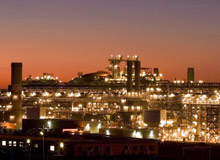
The Karratha LNG plant in Western Australia, 1,260km north of Perth, is one of the largest in the country, producing around 12 million tons of LNG a year for the Japanese and South Korean markets and also supplying 65% of the gas required by the Western Australian domestic market.
The plant, which is operated by Woodside Energy Ltd for the North West Shelf Venture (NWSV), has four trains which were opened between 1989 and 2004 (1989 LNG trains one and two, 1992 LNG train three, 2004 LNG train four) although the plant was first commissioned for processing domestic gas in 1984. There are two 130km trunk lines to carry the gas to the shore, five 125,000 bpd condensate stabilisation units and two LPG fractionation units.
The plant receives gas from several well known fields including Goodwyn, Waneae, Rankin, North Lambert, Hermes and Cossack and also tiebacks from Echo-Yodel and Perseus. The facility has 430 staff including 240 permanent staff and 190 contractors.
The NWSV includes: Woodside Energy Ltd. (16.67%) (Operator), BHP Billiton (North West Shelf) Pty Ltd (16.67%), BP Developments Australia Pty Ltd (16.67%), ChevronTexaco Australia Pty Ltd (16.67%), Japan Australia LNG (MIMI) Pty Ltd (16.67%) and Shell Development (Australia) Proprietary Limited (16.67%).
LNG loading
The LNG from the terminal is exported from an 850m jetty which has a loading rate of 10,000m³ an hour. On average the loading of an LNG ship takes about 22 hours.
The LPG and condensate produced from the site are exported from an alternative 450m jetty. Propane and butane products are loaded at about 1,500m³ an hour and condensate at 1,000m³ an hour.
Karratha expansion
In April 2007 Woodside Energy announced their phase V expansion at the Karratha gas plant, which included the addition of a fifth liquefaction train (4.4 million tons per annum) and also other infrastructure including: acid gas recovery unit, the third fractionation unit for the site, train five jetty extension spur and loading facility, two new gas turbine power generation units, fuel gas area extension, a third boil-off gas compressor for the site, a control system upgrade and tie-ins to existing facilities.
The A$2.6bn project was carried out by a joint venture between Foster Wheeler Energy and Worley Parsons. ABB have supplied 15 Venturi flowmetres for the project for gas flow measurement. The new LNG train was open and in operation delivering loads of LNG for export on 30 September 2008 following the commissioning process currently underway.
Modular design
The LNG phase V expansion entered the EPC (Engineering, Procurement and Construction) phase in March 2005. During the final detailed design stages it was decided to adopt a modular approach to the construction of the new train and also to follow the design of the fourth train quite closely (phase IV expansion project). In the end the construction resulted in about 60% modular methods.
One of the major problems was the modularisation of the complex pipe work at the plant, which required 75 different large structures and more importantly how best to fit the pipe work together from the different modules.
This design work was carried out by Foster Wheeler Energy at their Reading offices and involved specialised computer-generated modelling.
By July 2005 construction of the modules had started at the Batam Yard in Indonesia and by the end of the first half of 2006 the module construction was almost completed with deliveries occurring in the third quarter of 2006.
The site at Karratha had already been prepared and was ready to accept the modules by October 2006.
Modules were transported by self-propelled motorised trailers from the jetty (after delivery by roll-on roll-off ship) over a few kilometres to the site where they were offloaded directly onto the prepared foundations (five modules weighed in excess of 1,000t but most weighed around 300t, module weight range was from 35t–1,800t).
The tolerances of the engineering and the site civil engineering allowed the modules to fit together millimetre perfect. There have been 17 module shipments, the heaviest being 2,400t (total module weight was 18,000t).
The installation has four jetty loading arms, eight main compressors, one gas turbine generator and a 33kV substation.


